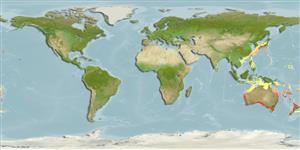Classification / Names
Common names from other countries
Main reference
Size / Weight / Age
Max length : 49.0 cm SL male/unsexed; (Ref. 33839); common length : 18.0 cm SL male/unsexed; (Ref. 9832)
Environment
Marine; reef-associated; depth range 15 - 365 m (Ref. 9832)
Climate / Range
Subtropical, preferred ?
Distribution
Western Pacific: off New Zealand and temperate waters off Australia; also known from one collection made northeast of Rockhampton, Queensland, Australia, and from one collection in the Chesterfield Island region of the Coral Sea; may reach Indonesian waters. Closely related to Callanthias japonicus from Japanese waters and from Callanthias platei from the southeast Pacific; all three taxa may be subspecies of a single wide-ranging species.
Countries | FAO areas | Ecosystems | Occurrences | Introductions
Short description
IUCN Red List Status (Ref. 115185)
Threat to humans
Harmless
Human uses
More information
Common namesSynonymsMetabolismPredatorsEcotoxicologyReproductionMaturitySpawningFecundityEggsEgg development
ReferencesAquacultureAquaculture profileStrainsGeneticsAllele frequenciesHeritabilityDiseasesProcessingMass conversion
Tools
Special reports
Download XML
Internet sources
Estimates of some properties based on models
Phylogenetic diversity index
PD50 = 0.5039 many relatives (e.g. carps) 0.5 - 2.0 few relatives (e.g. lungfishes)
Trophic Level
3.1 ±0.30 se; Based on food items.
Resilience
Vulnerability
Moderate vulnerability (44 of 100)
Price category
